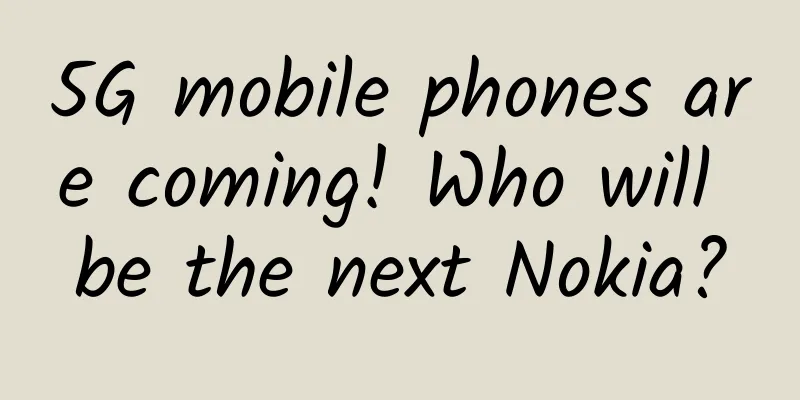5G mobile phones are coming! Who will be the next Nokia?

|
"With 43 million analog mobile phone users, this market can't be wrong." During the transition from 1G to 2G, a Motorola executive was unconcerned about the digital threat. "We didn't do anything wrong, but I don't know why we lost." During the transition from 3G to 4G, Nokia phones failed to seize the opportunities of the smartphone era and declined. The former Nokia CEO said this at a press conference when the company was merged into Microsoft. Do you still remember "the fighter jet in the cell phone"? This slogan was so awesome that Zhao Benshan got it to perform on the Spring Festival Gala. Bird has been the sales champion of domestic mobile phones for many times. Unfortunately, after MediaTek launched its famous Turn-Key solution, it "flattened" the threshold of the mobile phone industry. In order to maintain its technological advantage, Bird, which insisted on being a "fighter among mobile phones", chose to cooperate with Texas Instruments and rejected MediaTek's solution. Subsequently, the "fighter" was submerged in the wave of "copycat phones". In June 2018, the 3GPP 5G NR independent networking standard was completed, marking the beginning of a new era for the mobile industry - the 5G era. 5G is coming! 5G mobile phones are coming too! Not long ago, the "Ericsson Mobility Report 2018" was released, and the "5G Device Outlook" section in the report attracted attention... The report pointed out that the first commercial smartphones supporting 5G mid-band are expected to be launched in early 2019, while commercial smartphones supporting 5G high-band (millimeter wave band) are expected to be launched in mid-2019. As we all know, existing 4G mobile phones support more than 20 frequency bands including GSM/WCDMA/LTE, while 5G NR supports a wider frequency band range from 450MHz to 52.6GHz. 5G mobile phones must not only support existing LTE frequency bands, but also support higher frequency and wider range 5G frequency bands, which poses new challenges to 5G mobile phone design. The 5G frequency band is divided into two major frequency bands: less than 6GHz and millimeter wave, and the two frequency bands face different challenges. First, for frequency bands below 6 GHz, the RF front end is a tough nut to crack. For frequency bands below 6GHz, 5G mobile phones are expected to use the basic 4G design architecture, but the RF front end is a major challenge. The so-called RF front end (RFFE) is located between the transceiver and the antenna, and includes filters, power amplifiers, low-noise amplifiers, duplexers, RF switches, etc. Its performance directly affects the mobile phone signal strength, call quality, connection reliability, connection speed and power consumption. The earliest mobile phone RF front-end was very simple, with an antenna connected to a duplexer, power amplifier and low-noise amplifier. However, as mobile phones support more and more frequency bands, each band requires an independent duplexer, power amplifier and low-noise amplifier, which makes the RF front-end more and more complex, and faces greater challenges in integration difficulty, cost and performance. For example, if a mobile phone supports 20 frequency bands, it will need 20 duplexers (40 filters). If the phone supports 4*4 MIMO, that is, it is equipped with 4 antennas, the number of filters can reach 160. In short, in the 5G era, early 5G deployments will adopt a hybrid networking approach with 4G. The newly introduced 5G frequency bands, carrier aggregation, MIMO, dual connection and other technologies mean that in order to achieve high-performance, low-cost RF functions in the small space of smartphones, higher requirements are placed on RF components, new material processes and integrated design. The overall design of the RF front-end will face more severe challenges. Second, for the millimeter wave frequency band, 5G mobile phone design faces new challenges. First, why do 5G mobile phones need to support millimeter wave frequency bands? Technically speaking, there are four major technologies to improve mobile phone Internet speed: wireless frequency bandwidth, QAM modulation, carrier aggregation and MIMO technology. For 4G mobile phones, in theory, if they support maximum 5CC carrier aggregation (LTE maximum channel bandwidth is 20MHz, 5CC carrier aggregation means 100MHz bandwidth), 256QAM modulation and 4×4 MIMO technology, the maximum download rate can be close to 2Gbps. However, this is only the theoretical limit of 4G mobile phone speed. In actual design, supporting higher-order modulation methods and more carrier aggregation means more power consumption and requires more complex and higher-performance RF and baseband circuits; higher-order MIMO technology, that is, supporting more antennas, means facing limitations in the physical size, isolation and radiation efficiency of the antenna. However, the KPI of 5G is to support a peak rate of 10-20Gbps, which is obviously a task that 4G mobile phones cannot accomplish. Therefore, 5G mobile phones need to support millimeter wave frequency bands for two main reasons:
Compared with the frequency band below 6GHz, the propagation loss of high-frequency millimeter waves is higher, the coverage distance is shorter, the signal's ability to penetrate walls is weaker, and it is also affected by oxygen, humidity, fog and rain. In view of this, in order to improve signal coverage, multiple antennas and beamforming technology are required at both the base station and the mobile phone. The problem is that the biggest issue facing millimeter wave beamforming is attenuation caused by human body blocking. Simply put, when we hold the phone in our hands or put it to our ears to make a call, the millimeter wave beam signal will be blocked. To this end, according to an IEEE technical report, in order to support millimeter wave beamforming, 5G mobile phones need to introduce multiple beamforming modules (5G Beamforming Module) and distribute these beamforming modules on the back cover of the mobile phone. ▲Basic architecture diagram of 5G mobile phone system (newly introduced beamforming module, which contains a phased array composed of multiple antenna units) ▲Multiple beamforming modules are distributed around the back cover of the 5G mobile phone Why is it designed like this? This is to avoid attenuation caused by the human body. Research shows that we hold our phones in four main ways: Each posture may block the millimeter wave beam, but if multiple beamforming modules are distributed around the mobile phone, it means that no matter how we hold the phone, there will always be two beams that will not be blocked. For example, in the first holding posture, beamforming modules 1 and 2 will not be blocked. This is a design that exchanges "quantity" for "quality" to overcome the attenuation caused by the human body. At the same time, this design approach also has the advantages of achieving higher spatial multiplexing gain and facilitating heat dissipation. It is worth mentioning that this design may mean that the traditional SIM card slot will disappear and be replaced by an eSIM card directly soldered into the circuit board. Because multiple beamforming modules need to be installed around the back of the phone, this design may also cause early 5G millimeter wave-supported phones (or prototypes) to be bulky and ugly. A few days ago, some media reported that Motorola will equip its Moto Play Z3 smartphone with a 5G communication module. As shown in the picture above, this 5G communication module looks like a mobile phone cover with a 5G logo printed on the back. Netizens generally complained that this "cover" is too ugly. Since there is no more information about the 5G communication module, it is not known whether the 5G communication module supports millimeter waves, but industry insiders speculate that this "lid" may adopt a distributed beamforming module design. So it looks a bit bulky and ugly. Looking back at history, every upgrade in the mobile industry will trigger design changes in the terminal field and a reshuffle of the industry. In the past, we were talking about Motorola, Nokia and BlackBerry, but today, the ones taking the stage are Apple, Huawei and Samsung. As the saying goes, you finish your singing and I take the stage, and each of us will be the leader for three or two years. 5G mobile phones are coming. First of all, they will face huge challenges and changes in design. Will the fiercely competitive mobile phone industry change its flag again? Who will be the next Motorola? Who will be the next Nokia? |
>>: Say goodbye to data "roaming" fees: 10 questions, everything you want to know is here
Recommend
Network programming - starting from establishing a TCP connection
[[388071]] Preface Network programming is somethi...
RAKsmart dedicated server flash sale starts from $30/month, high-defense server starts from 79/month, US/Japan/Korea/Hong Kong data centers
RAKsmart is a long-established foreign merchant o...
API has become the biggest risk exposure in data security. How to win the “data protection war” in the digital age?
Nowadays, data has become an emerging production ...
Important event preview: Here is an invitation to smart education
With the release of the "Education Informati...
WiFi 7 for ubiquitous access
It is now common to use mobile communication netw...
5G is changing society, but is millimeter wave still missing?
Three years ago, 5G ushered in the first year of ...
Adding more content rights makes 5G packages more popular
China Telecom's 5G package users have accumul...
Without IPv6, there is no future. Let’s talk about the necessity of deploying IPv6.
The first large-scale IPv6 transformation was in ...
LiteServer 15th Anniversary 15% off, 2GB RAM NVMe hard drive package starts from €5.1/month
LiteServer is carrying out a promotion for its 15...
What is 5G network slicing?
In today's fast-paced, hyper-connected world,...
Alibaba Cloud invests 200 billion yuan in data centers to take the lead in new infrastructure
Alibaba Cloud announced yesterday that it will in...
Thirty years of changes and evolution of Internet core protocols
When the Internet began to be widely used in the ...
Architecture Design: Sidecar Pattern Explained
Context and Questions Modern applications usually...
How to use WireShark to capture packets and see through network requests
[[385882]] This article is reprinted from the WeC...
Scenario-based × disruptive innovation: polishing the minimalist "light" with users
[[423919]] "Users asked for an optical netwo...









